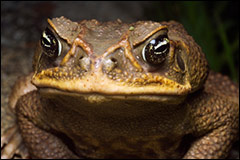Dear Umbra,
I’m currently studying in Australia. I was recently in Queensland, where as you probably know, cane toads are a huge problem. There are over 200 million of the toxic toads, and this invasive species has been killing off native wildlife and just in general causing lots of problems. In fact, they have huge hunts where they gas thousands of the toads.
Recently, when some friends and I saw the toads (hundreds of them come out at night, it’s scary) we debated killing them, because it’s really just doing the environment a favor. Now, my question is: would it have been right for me and my buddies to have cruelly squashed a few toads to help save Australia’s wildlife, even if the toads would die a horrible death and the death of only a few toads would have no impact on their destructive tendencies? I’ve been wrestling with this for a while. I didn’t actually kill any, but when/if I go back, what should I do?
Basically, I’m asking is killing one bad animal right if it’s a horrible death and will do little or nothing to stop that species’ rampage?
Aaron
Ithaca, N.Y.
Dearest Aaron,

You make me want to croak.
Photo: iStockphoto
No. To emphasize the message from our garden pests column: don’t do anything with animals and plants unless you know for sure it is the right thing to do.
What you’re asking is in part a moral question. The answer seems embedded in the question, to be honest. You don’t seem to want to have cruelly killed the toads — your use of the word cruel gives you away — and you have the right instincts. Though cane toads seem without redemption, killing them in cruel and unusual ways degrades both them and you. Clubbing them or squishing them is also not recommended from an environmental standpoint, thank goodness, because I am not The Ethicist. Unless you can positively identify the toad and know what the recommended steps for eradication are, doing nothing is the best choice.
All the various cane toad authorities give the same instructions about individual citizens killing the cane toads, which I will get to in a moment after I catch the rest of us up on Bufo marinus. This giant toad was introduced to Australia in 1935 to eat a sugar-cane pest. Only after it was introduced did the poor naifs who brought it learn two things: it couldn’t physically reach the pests — sounds like they were bilked — and it had no Aussie predators. Oh, and it reproduced like mad. Now these giant mushy toads are spreading over Australia, eating, poisoning, and displacing all sorts of endemic species, from snakes to mammals to frogs. One particularly revolting part of the cane toad is its poison-filled shoulder pads (yes, yes, insert joke about Joan Collins here), so slamming it with sticks is immoral and dumb, because the last thing you want is poison in your eye.
Australia would like to get rid of the cane toads, so killing them is actually approved of by various powers that be. You just need to be sure it’s the right toad, and do it as humanely as possible.
There are some nice native froggies down under (no other toads), and the last thing you want to do is go all cane toad on them. So, just like our garden pests, learn to identify the cane toad vs. nice froggies, and learn the best way to control them. The best way to dispose of them is apparently at the egg stage, by scooping their (revolting) egg strings out of bodies of water and composting them. Don’t try to kill any tadpoles, in case you confuse them with innocent frog tadpoles. Brush up on your adult Australian frogs (page includes frog calls!) and the adult cane toad itself. When you are certain you have found a cane toad, or pack of cane toads, you are supposed to gather them up carefully. Put them in the fridge for a few hours to sedate them, and then into the freezer for a day to kill them. Then throw them out somewhere. Ick.
Be cautious when dealing with pests of all sorts, is the moral here. The cane toad is in Australia because someone was not cautious, and native frogs are now under threat. A little caution has its moments.
Bufoly,
Umbra
Get up close and personal with the scourge of Queensland, the cane toad:

